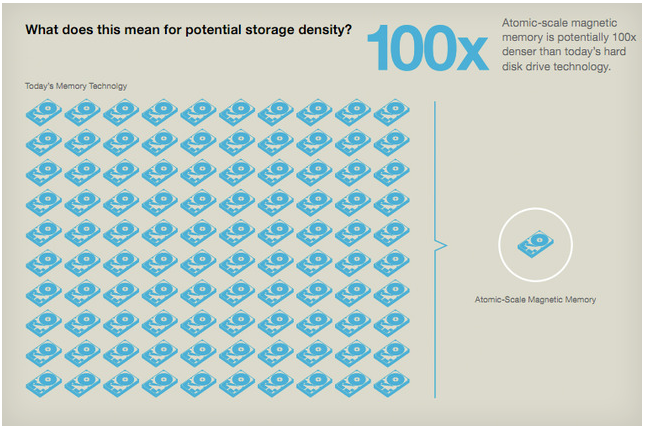1 bit on 12 atoms
Readers of the IBM blog know how much effort and money the company invests in various research and development, but they are far from always able to immediately answer the question: “What did the blue giant have done in the last X years?” First of all, there are a lot of such things, they are constantly surround us in modern life, and therefore determine what is what, and where roots grow from, is not always easy.
Therefore, we strive to tell readers of our blog about what research is taking place at IBM today and what they will lead to tomorrow. The highlight of the program is a publication in a reputable journal Science, which tells how IBM's specialists managed to find a way to pack 1 bit of information into a structure of 12 atoms, thus creating the world's smallest magnetic data storage device.

')
This is another breakthrough, the final realization of which the industry will most likely need not a year, not two or even five, but decades, but it perfectly illustrates the potential of the future development of methods for storing electronic information.

Until now, physicists did not really know how small (on an atomic scale) a magnetic drive could be before the laws of quantum mechanics began to influence it, preventing effective and reliable data storage for a long time. Combining eight atoms together, for example, it is impossible to obtain a stable magnetic structure - this is what Andreas Heinrich, an IBM physicist responsible for this important discovery, says: “The whole system spontaneously“ jumps ”from one state to another, which does not give any reason to talk about or data storage. She can change her state thousands of times per second. ”
Another problem is that it is difficult to force neighboring data bits to “not interrupt” each other. Modern hard drives have a structure known as “ferromagnetic” - this means that a large number of atoms are stuck together and they must turn towards the same magnetic pole, like a compass needle or a magnetic on your refrigerator.

The fact that they created in IBM contradicts this principle, since a 12-atom antiferromagnetic structure is used, which means that neighboring atoms “look” in different directions. This prevents some atoms from mixing with others, which is important when 12 atoms are used simultaneously to store one bit: “In ferromagnet, all atoms complement each other in order to switch large data clusters, and switching each cluster triggers the reaction of the next cluster. Therefore, you cannot control them independently of each other, ”says the author of the discovery. "But there are no big switchings in antiferromagnet, so you can place atoms very close to each other without harm to the stored information."
IBM used a scanning tunneling microscope (STM) - something that was invented within the company about 30 years ago in order to “see” atoms and, most importantly, move them along the grid structure.
Strictly speaking, about the very "revolutionary" discovery - 12-atomic storage devices will be much, and this is not a joke, much smaller than today's hard drives. Friends of our company at Hitachi estimate that their hard disk uses an average of about 800,000 atoms to store one bit of information. This applies to expensive and high-end equipment, and in the disks that we use everywhere, it takes about a million atoms to store 1 bit of data. With a simple mathematical action, we get a result in which an 8 GB flash drive uses about 69 quadrillion atoms.
So what keeps the industry from already starting to produce antiferromagnetic flash drives and sell in all stores around the world? A few things. First, the working temperature: 1 degree Kelvin (about -270 degrees Celsius). Researchers believe that at room temperature it will take about 150 atoms to store one bit of information, which is not so bad compared to the existing architecture, but still 10 times higher than the achievable minimum.
However, there is a more serious and real problem: no one has ever tried to build something so miniature for the mass market, outside the laboratory. And, of course, it is impossible to do it “for cheap”: “Many people are working to solve this problem, but so far no one has been successful.”

There is one more thing that strongly influences how leading world companies behave - Moore's Law. This long-playing phenomenon, according to which the number of transistors in circuits should double on average every two years, has been in disgrace over the last few years, as chip manufacturers will soon run into the physical ceiling of the process and in order for progress to remain stable, they are absolutely and fundamentally new architectures and atomic structures. IBM's long-term goal in this light is simple - to create a memory that you can buy, and which is 417 times denser than traditional DRAM and about 10,000 times denser than SRAM. This means that in computers of tomorrow there can be several terabytes of RAM or processor cache.
Andreas Heinrich himself says that when he first saw the structure of 12 atoms holding a charge for a sufficient period of time to call the whole system stable, he was shocked - for four hours in a row he sat in his laboratory, switching the state of atoms back and forth: “In fact, I just blown away. This is possible once in history, even for a person who constantly deals with such things every day, when something like this becomes really real and accessible, we all blow the roof away. ”
Source: https://habr.com/ru/post/136389/
All Articles